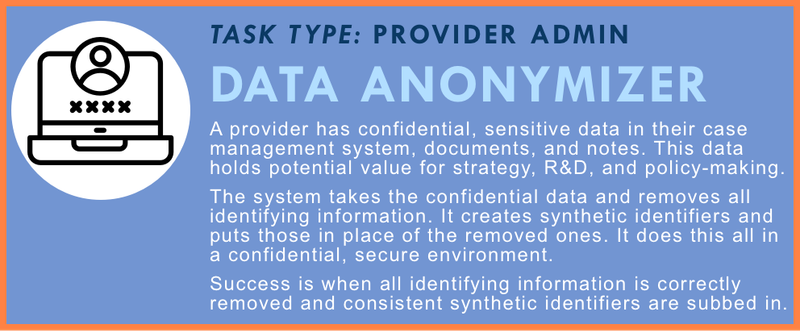Data Anonymizer

Help providers transform confidential data into usable, secure datasets by removing identifiers and inserting consistent synthetic replacements.
Task Description
Legal help organizations, courts, and justice system actors handle large volumes of confidential data—from case notes and filings to intake records and communications. This data contains valuable insights that could improve services, support research, inform policy, or train safer AI tools. But before it can be used for those purposes, it must be de-identified to protect the privacy and safety of clients and staff.
This task involves a system that acts as a secure, automated de-identification and synthesis engine. It scans confidential records—including text fields, uploaded documents, and structured case management data—to identify and remove personally identifying information (PII), such as names, dates of birth, addresses, phone numbers, and unique case numbers.
Rather than just redacting content, the system inserts synthetic identifiers—fictional, non-reversible replacements that remain internally consistent. For example, a client named “Maria Lopez” might become “Client A07” throughout a record set. This preserves the structure and meaning of the data while ensuring no real person or organization can be re-identified.
This task is especially valuable for organizations looking to safely share data with researchers, build internal dashboards, or develop AI tools without violating confidentiality rules. It enables use of rich, detailed records while fully protecting sensitive information.
Success means the data has been de-identified with high confidence—no identifying details remain, and the resulting synthetic data preserves accuracy, consistency, and utility for further use.
How to Measure Quality?
🔍 Comprehensiveness of De-Identification
- Detects and removes all direct identifiers (names, contact info, SSNs, etc.)
- Removes or masks indirect identifiers (e.g., rare job titles, specific locations)
- Applies across structured and unstructured data, including free-text notes
🧪 Accuracy of Synthetic Identifier Replacement
- Replaces each unique entity (e.g., a client, opposing party, attorney) with a consistent pseudonym
- Maintains logical relationships (e.g., same “Client A01” across files and documents)
- Avoids duplicating or reusing synthetic identifiers inappropriately
🔐 Security and Confidentiality Protocols
- Operates in a secure, access-controlled environment
- Logs all transformations and provides an audit trail
- Ensures irreversible transformation—original identifiers cannot be reconstructed
📊 Data Integrity and Utility Preservation
- Retains the structure and meaning of the original data
- Allows for timeline analysis, service pattern recognition, or machine learning on de-identified sets
- Preserves legal issue codes, service events, and narrative content minus PII
📈 Scalability and Workflow Fit
- Works across large datasets, file uploads, or database exports
- Can be run on demand or scheduled regularly
- Allows staff to flag and review borderline cases before final transformation
🧑💼 Review and Quality Assurance
- Provides reports on what was removed, what was synthesized, and confidence scores
- Supports spot-checks and sampling to ensure effectiveness
- Alerts if certain fields could not be fully de-identified (e.g., scanned handwritten notes)